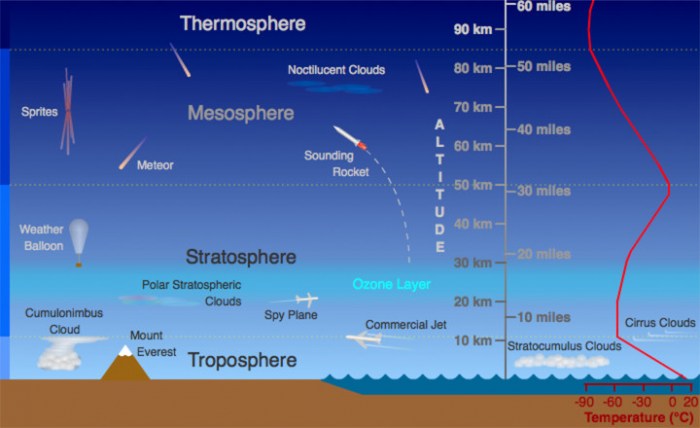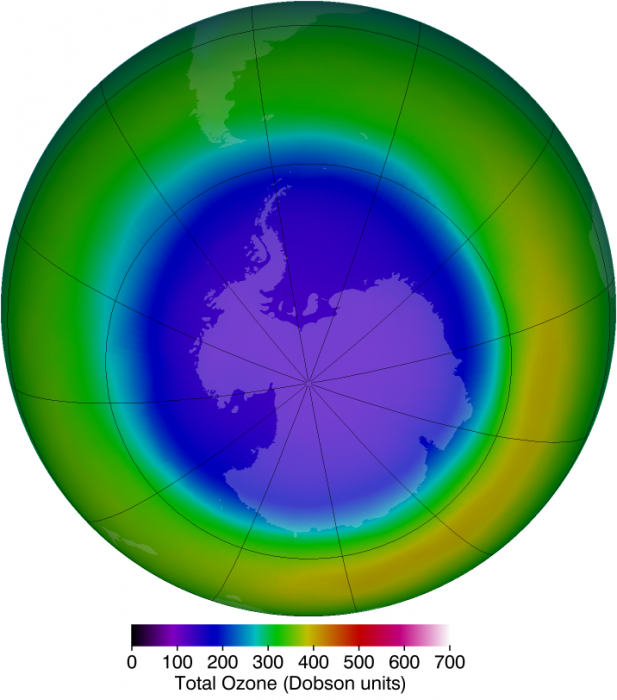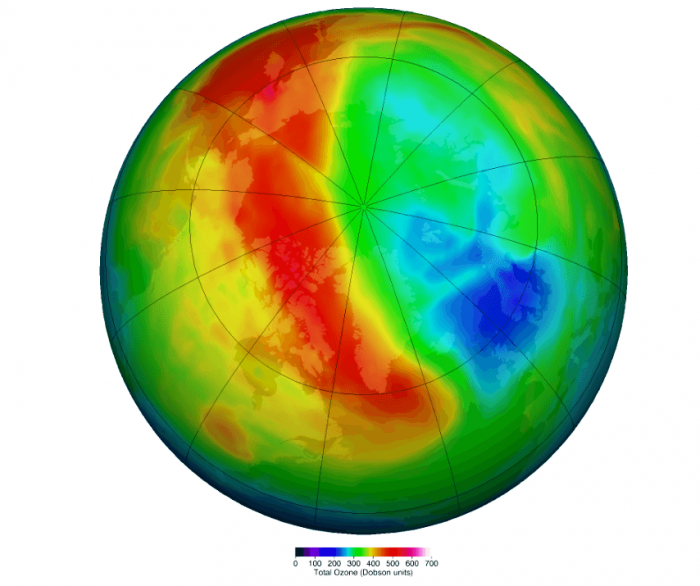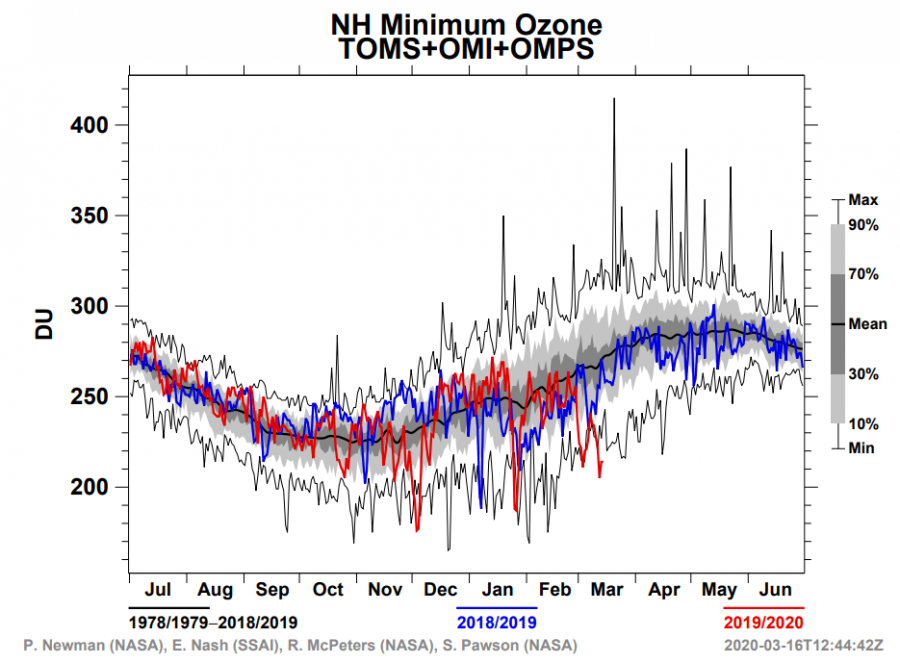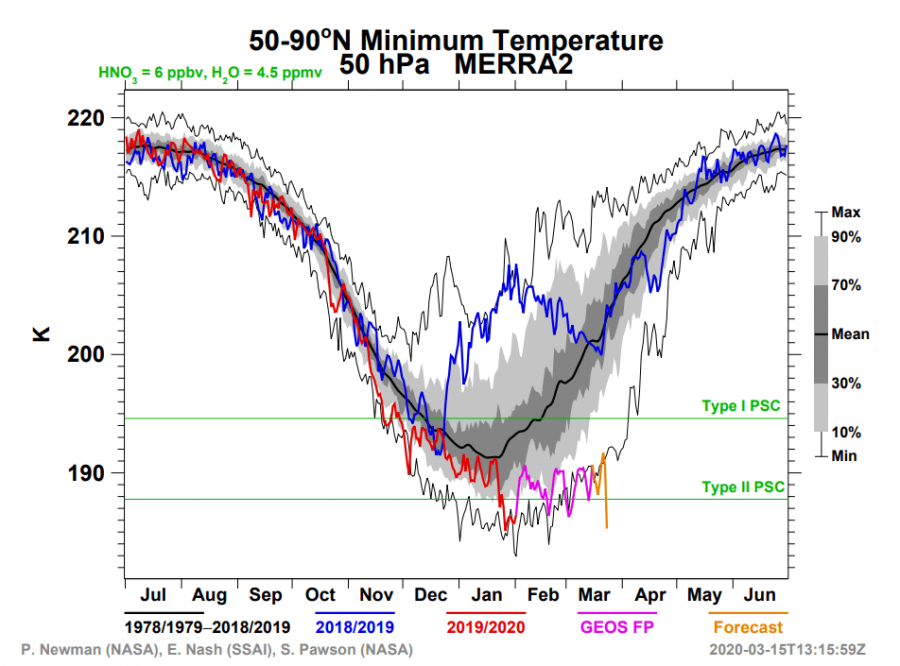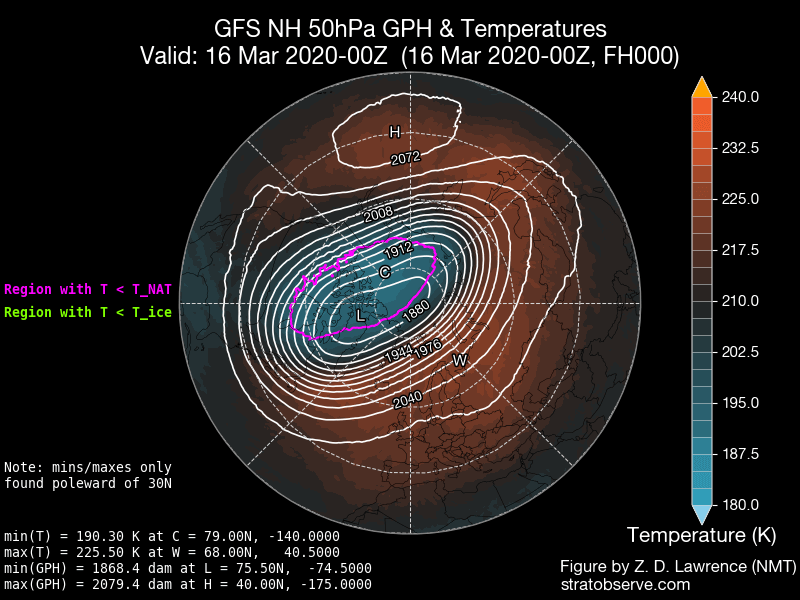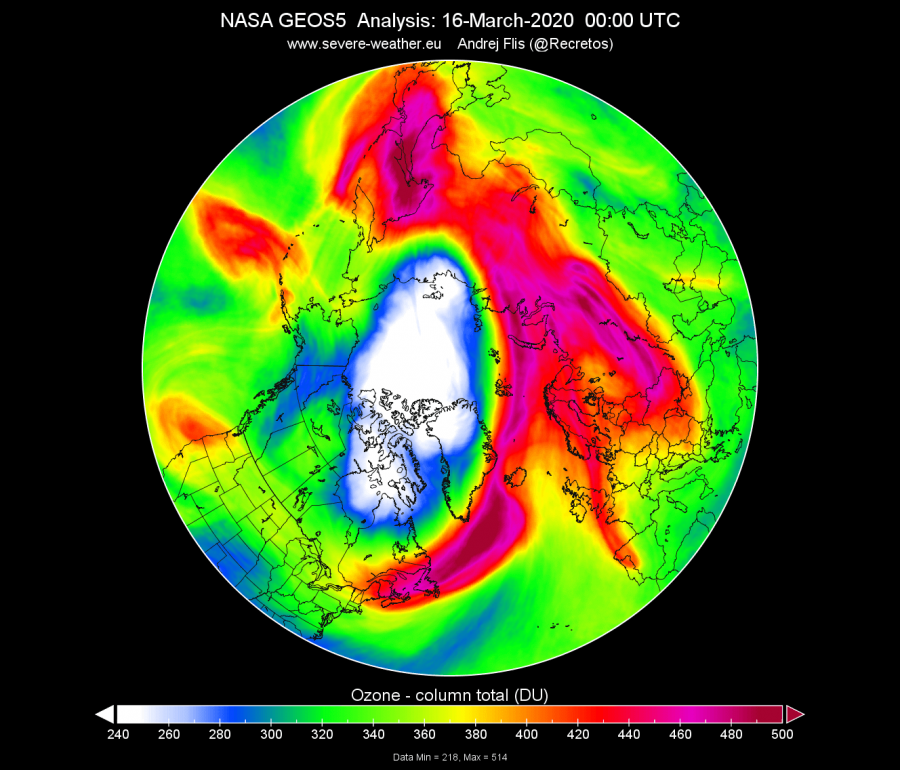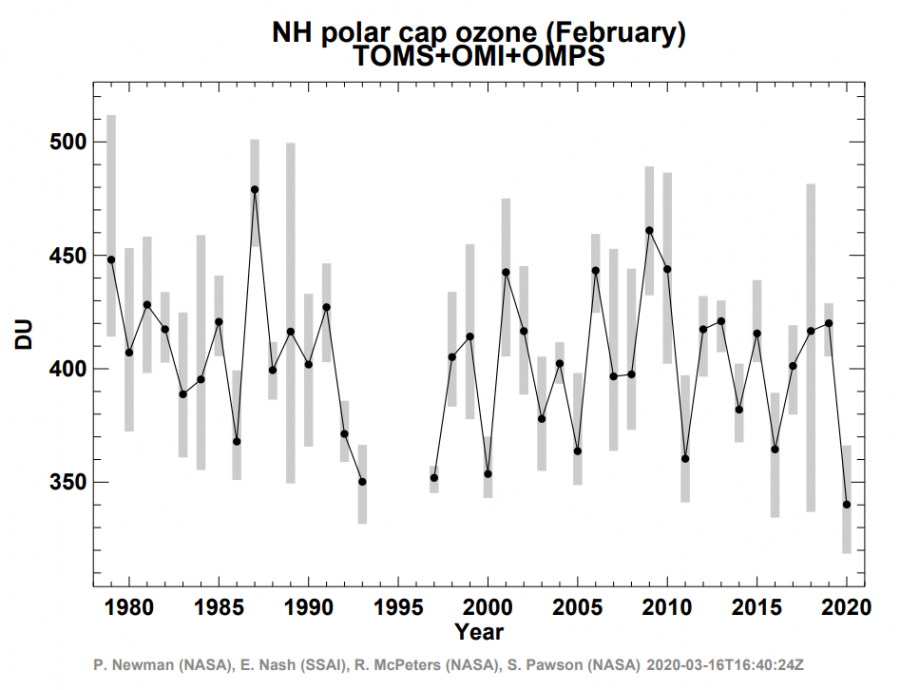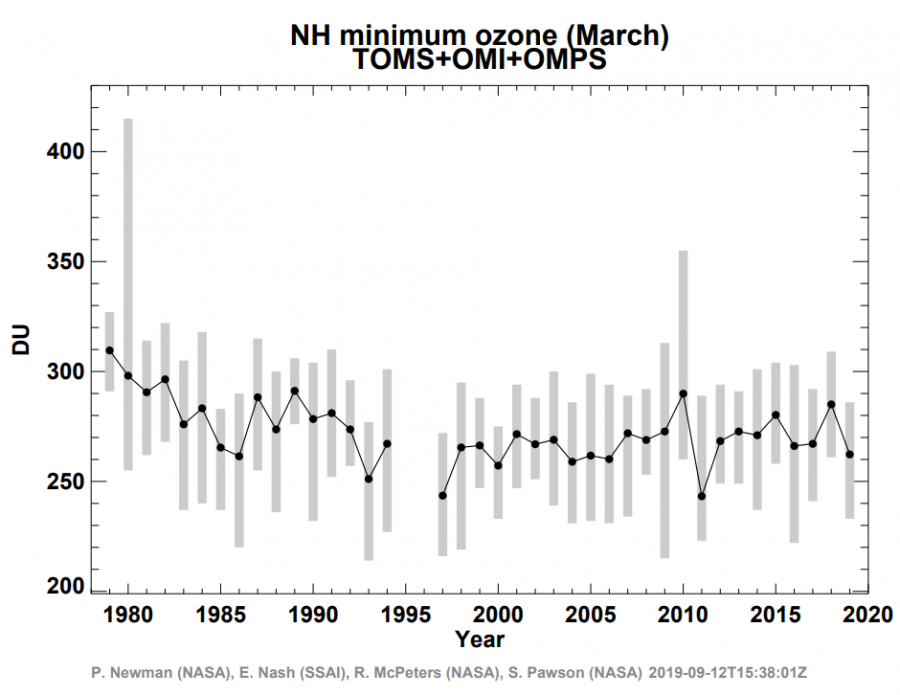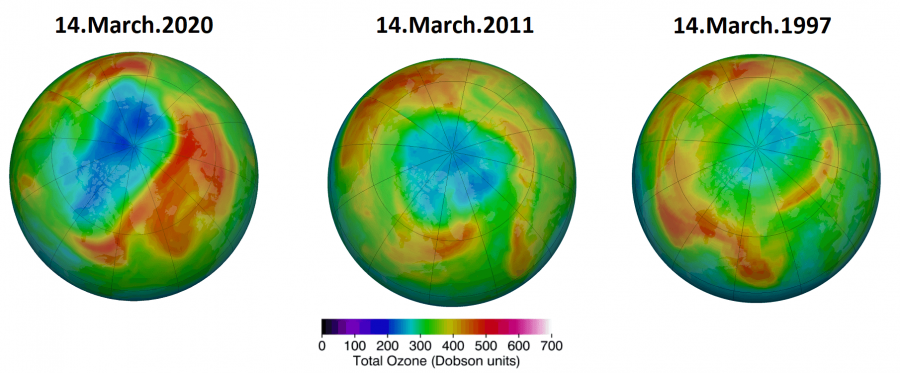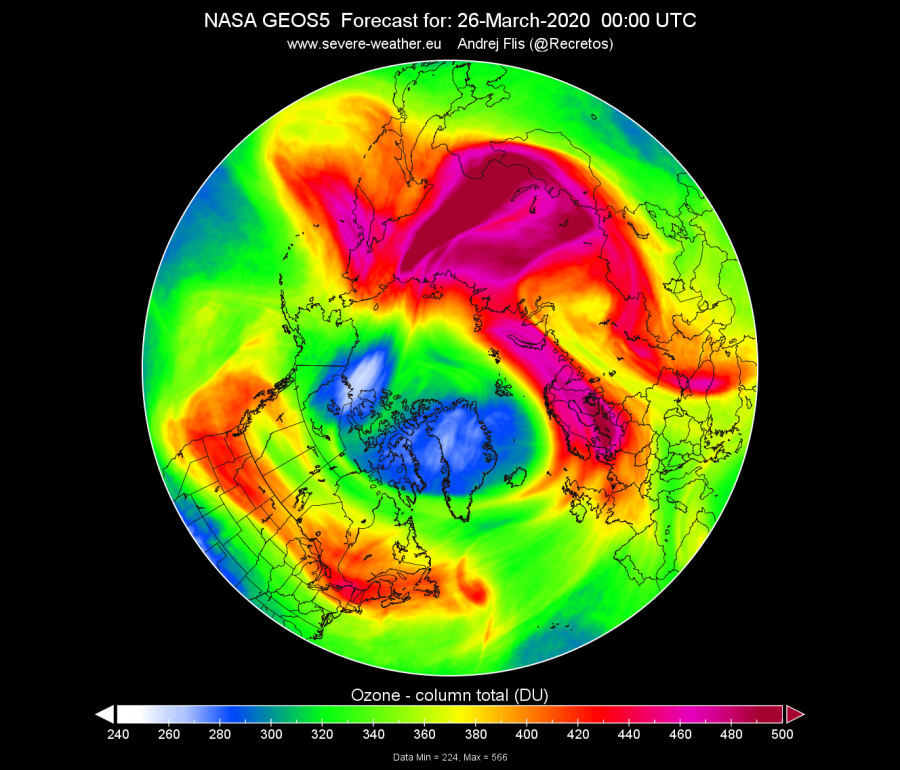It is a rather rare occurrence to see a larger area of sustained ozone depletion over the Arctic regions during the late winter/early spring season. But this year, records were broken, as an unusually large area of ozone depletion has formed.
We have all heard of ozone before. More likely in the context of the Ozone layer, which is the protective layer that shields us from dangerous ultraviolet (UV) radiation. It can be found between 20-30km altitude, as seen on the graphic below from UCAR. Under an ozone hole, that protective layer is gone, which can cause problems for living organisms, as more of the harmful solar UV radiation gets through. UV radiation is well-known to cause skin cancer in humans if one is frequently exposed. In the second image below, we see an example of the ozone hole over Antarctica in September 2000, seen as a large reduction of ozone values (a proper “hole”). Image is from the NASA ozone monitoring service.
In the past days/weeks, we have been monitoring the onset of unusually strong ozone depletion over the north polar regions. We already had a big drop in the minimum ozone values in late November 2019 and January 2020, due to a development of a “mini” ozone hole over northern Europe. These “mini” ozone holes over the North Pole do not form because of a chemical destruction process, like over the Antarctic due to the aerosols. Here the ozone layer is not destroyed, but just re-arranged/dispersed by specific weather circulation patterns, creating a temporary reduction in a certain area. The graphic below shows the ozone values over the Northern Hemisphere, on January 25th, 2020. We can see the “mini” ozone hole over northern Europe.
Looking at the minimum ozone graph, we can see the two strong low spikes in late November and January (red line). But these were just short-lived events, that tend to occur every year during the cold season. What really got our attention, was the overall reduction of ozone, in early March, when the values should actually be going up slowly. Something was off, and this time it was not just a quick low spike from a mini ozone hole, but a proper ozone destruction process. To find out the cause, we must research why the ozone gets destroyed in the first place.
The ozone hole over the South pole forms because of a chemical process that destroys ozone. That process includes very cold air (below -78°C), sunlight, and is powered by human emissions of harmful chloro-fluorocarbon (CFC’s) and hydro-fluorocarbon (HFC’s) aerosols. Cold temperature enables the stratospheric clouds to form, and then sunlight reacts with those clouds to start a photochemical process that destroys ozone, and thus the ozone hole forms and grows. Below is a photo of these stratospheric clouds, which are truly a spectacular sight to see.
Two days ago I saw this magnificent display of polar stratospheric clouds in Finnish Lapland. Just amazing!#pscs #nacreousclouds #lapland #finland pic.twitter.com/ANd5UOLwgL
— Thomas Kast (@ThomasKast1) January 2, 2020
As we mentioned, ozone destruction also needs sunlight, which is why this process is limited over the north pole. By late February and March when sunlight reaches the pole, the stratosphere over the north pole is usually not cold enough anymore to produce these clouds, which are essential for the ozone destruction process. In some years, like this year, the stratosphere is abnormally cold, and it can produce the stratospheric clouds at the same time that sunlight reaches the pole, starting ozone destruction. The graphs below show unusually low temperatures in the lower stratosphere at 50 hPa level (18-20km). We can see that the temperature goes below the cloud producing level (195K) every year, but usually, there is no sunlight to start the ozone destruction process. By the time sunlight reaches the pole again, the temperatures are already rising above the cloud forming threshold.
If we look at the weather map for pressure (geopotential height) and temperature for the 50hpa level (18-20km altitude), we have the coldest air outlined in pink. That shows the area which is cold enough for stratospheric clouds to form. Basically we can see the very strong and cold polar vortex, which dominates at this level. The map suggests that the stratospheric clouds are forming over northern Canada, Greenland, and the Arctic ocean.
Our own ozone analysis shows the ozone destruction in exactly the same area. In essence, this is an actual ozone hole, just like the “infamous” one over the Antarctic. It is unusually large for the Northern Hemisphere, and has record low ozone values, going down to 217 Dobson Units at lowest. It is still not as big and strong as the on over the South Pole. That is because the temperatures over the South Pole are much lower and widespread, and the ozone destruction process there is also more heavily boosted by the chloro-fluorocarbon (CFCs) and hydro-fluorocarbon (HFCs) aerosols.
The polar cap ozone graph, shows the comparison of ozone values for the past 40 years in February. This year we have seen the lowest February ozone levels across the north polar regions. It is likely that these are the lowest values in much more than just the past 40 years, as there were lower aerosol emissions further back and there is a general trend for the cooling of the stratosphere over the past decades. We can perhaps see a slow reduction trend in the graphs, especially in the early decades, as the human aerosol emissions were high.
The actual minimum values can usually better reveal the presence of an ozone hole. We don’t have full March 2020 data yet, since the month is not yet over, so the last data point is for 2019. But we can look into the past, to see that two years stand out, 2011 and 1997, with very low ozone minimum values for March, indicating some form of Ozone destruction and a likely ozone hole formation.
Comparing the March 14th data ozone analysis for 2020, 2011 and 1997, we can see that all three years have an ozone hole present. But, 1997 and 2011 were not as intense as this year, which will likely make this March ozone hole a record strong one, for many decades in the past and perhaps also into the future. We already thought in 2011 that the ozone hole that year ill not be surpassed for a long time. But only 9 years later, we are witnessing a much stronger event.
The future of the ozone hole is not as bright, because the stratosphere is set to undergo a stratospheric warming event. Temperatures are going to rise, as the influence of the Sun gets stronger as it starts to warm the polar region. Soon it will be too warm for the stratospheric clouds to form, and the ozone destruction process will slowly reduce. Below is the 10-day forecast of the ozone layer, which shows the reduction of the size and intensity of the ozone hole, altho it is still going to be present for some time.
We will keep you updated on any important further development. While you wait for more updates, don’t miss our article on the effects of the warmer Spring weather on the spreading of the new Coronavirus:
